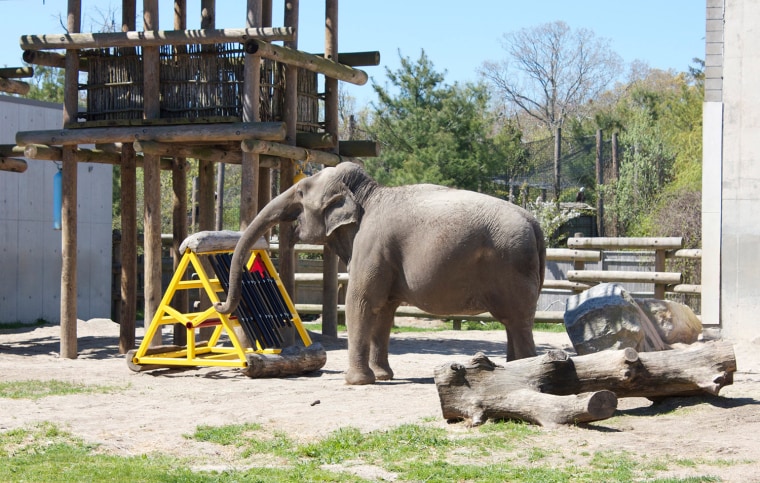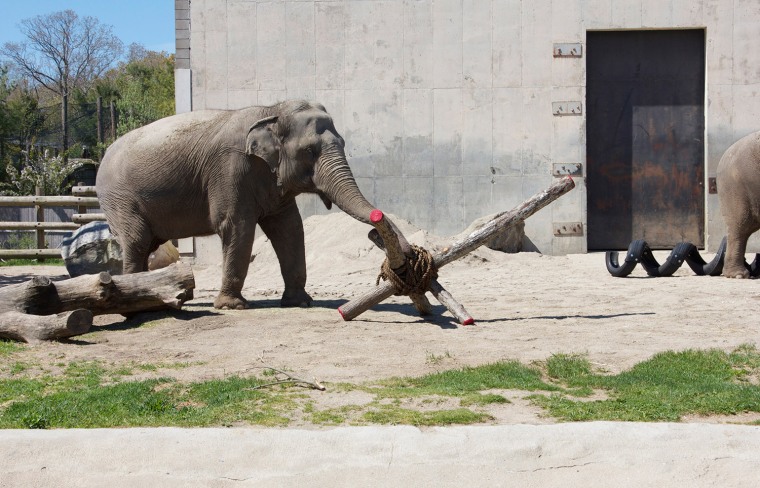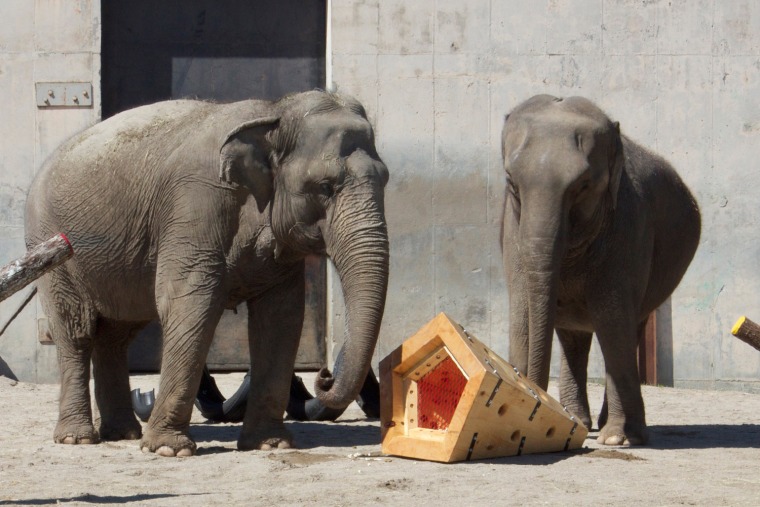
By Alessandra Hickson, NBC News
Asian elephants Emily and Ruthie are resident MacGyvers at the Buttonwood Park Zoo in New Bedford, Mass. -- hook up a light bulb or screw in a hanging installation and within the hour they’ll take it apart.
Emily has also been known to pick up sticks and drum – on logs, pots or anything nearby. If the beat is really good, her 8,000-pound body wiggles to the beat.
Ruthie, however, is more of a social butterfly, sniffing new people with the swing of her partially paralyzed trunk.
“Ruthie would crawl in your lap if she could,” said Shara Crook-Martin, Curator at Buttonwood since 2008. “She feeds off of interacting with people.”
There are more than 300 elephants in accredited U.S. zoos, according to the Association of Zoos and Aquariums, and keepers are looking for ways to engage these and other intelligent, endangered species.
So in 2010 Buttonwood turned to the Massachusetts College of Art and Design (MassArt).
“I like big problems and I like big problems solved,” said Professor Rick Brown, who answered the call by developing an elective course with his non-profit, HandsHouse Studio. Their objective? To make toys for elephants.
Toys for Elephants was brought to our attention by a 'Nightly News' viewer on Twitter. Do you have a #BigIdea that you'd like to share? Learn more here.
The elephants are “always thinking and they’re very, very clever,” said former director of the Buttonwood Park Zoo, William Langbauer, who left in 2012. He oversaw the zoo when Brown’s class first started making toys in 2010.
“To keep animals in human captivity, I think, it is incumbent upon us to do the best we can by them,” he said.
When Buttonwood’s trainers first met Emily in 1968, she was only four years old.
Ruthie was discovered abandoned in a trash dump in Danvers, Mass., in 1986.
Despite years of rehabilitation, both elephants lacked social skills and Buttonwood’s trainers wanted to further enhance their lives.
“Elephants are very cognitive animals, very complex and very emotional,” said Crook-Martin. “Their sheer size and strength makes it challenging to come up with things to keep them mentally stimulated.”
Brown’s one-semester course challenges students from multiple disciplines to develop beneficial elephant toys.
“They did an incredible amount of research,” Langbauer said of the classes. “They were grilling the zoo keepers and they would come ask me questions about independent research they had done online and in the library.”
Then the students met Emily and Ruthie.
'Sky's the limit'
For music-loving Emily, one student created the “Drum Roll” xylophone. Elephants bang the instrument with sticks or rub its surface to make music. In addition, there’s a “human xylophone” that passersby can play, which has led to “elephant jam sessions."
A helix-shaped “Tire Tendril” can be rolled and picked up, providing exercise.

And another toy makes noise as the elephants play, thanks to a larger than life rainstick.

“What started as a novel concept has become a win-win situation for the students, for us and the animals,” said Crook-Martin who hopes the unique partnership continues for many years.
Brown plans to expand the Toys for Elephants program nationwide and develop enrichment for other animals, such as bears or orca whales. “Elephant by elephant, we start to see the difference,” he said.
Buttonwood’s trainers and keepers said they could also envision the program being adapted for other species.
“Keepers look at these toys and say we could this with a bear or large cats by adapting it or making it smaller,” said Crook-Martin. “Sky’s the limit with these ideas.”
Until there’s more funding available, Brown and his class will stay focused on developing toys for Buttonwood’s elephants.
“If the elephants have some ways to interact it will make their days far more interesting,” he said. “That will make them much happier in captivity.”
'Once in a lifetime experience'
Melissa Fabbri, 22, heard buzz about an elephant class at MassArt.
“I was really excited about working really big,” said Fabbri, who graduated from MassArt’s jewelry and metalsmithing program in May.
After struggling with mediums and sketches, she examined the toys that were Emily and Ruthie’s favorites. That’s when she came up with the “Diamond,” which holds treats that only become accessible when the elephants roll it around. “The point is to encourage movement for them,” said Fabbri.
“The Diamond” is a favorite for Emily and Ruthie, who both love a good puzzle.

“It’s so important to keep these amazing animals entertained, to help make their lives more enjoyable,” said Fabbri.
For this former student, who likes to call Ruthie “the underdog” there’s only one-way to describe designing for elephants. “It was a huge, once in a lifetime experience.”
NBC's Whitney Rodgers contributed to this report.
